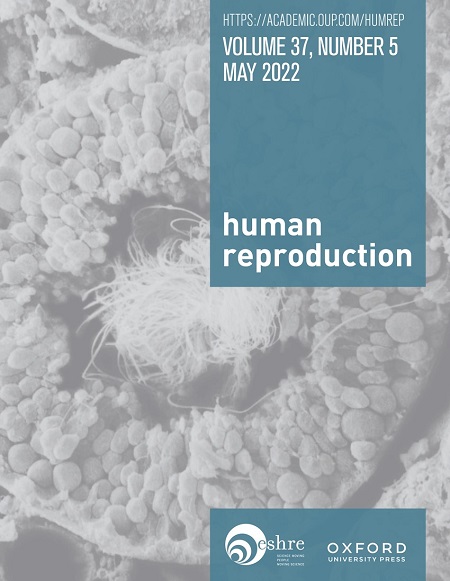子宫内膜异位症与绝经类型和年龄的关系:来自5项队列研究的27948名妇女的汇总分析
IF 6
1区 医学
Q1 OBSTETRICS & GYNECOLOGY
引用次数: 0
摘要
研究问题:子宫内膜异位症与绝经的类型和年龄有什么关系?子宫内膜异位症患者接受手术绝经的风险是自然绝经的7倍,更有可能经历手术和自然绝经的过早或提前绝经。已知情况子宫内膜异位症与卵巢储备减少有关,但其与绝经类型(手术或自然)和时间(特别是过早和提前绝经)之间的关系的证据有限。患有子宫内膜异位症的女性更有可能接受子宫切除术和/或卵巢切除术(单侧或双侧),但这些手术的平均年龄尚不清楚。研究设计、规模、持续时间该研究分析了1996年至2022年间在英国、澳大利亚、瑞典和日本进行的5项队列研究中27948名女性的个人数据。参与者/材料、环境、方法排除因绝经前子宫切除术保留卵巢或使用绝经期激素治疗而无法确定绝经类型和年龄的妇女。通过自我报告和管理数据确定子宫内膜异位症。手术绝经定义为绝经前双侧卵巢切除术。细灰色亚分布风险模型估计手术和自然绝经的风险比(hr)。绝经年龄由末次月经年龄或双侧卵巢切除术年龄决定。线性回归评估绝经年龄的平均差异,而多项logistic回归估计分类绝经年龄的优势比(ORs): <40岁(过早)、40-44岁(早期)、45-49岁、50-51岁(参考)、52-54岁和≥55岁。自发性卵巢早衰(POI)被定义为40岁前的自然绝经。3.7%的女性确定了子宫内膜异位症。到随访结束时,7.9%的人手术绝经,58.2%的人自然绝经。使用竞争风险模型,患有子宫内膜异位症的女性手术绝经的风险增加了7倍(HR: 7.54, 95% CI 6.84, 8.32),而经历自然绝经的可能性较小(HR: 0.40, 95% CI 0.33, 0.49)。子宫内膜异位症患者的手术绝经期平均提前1.6年(19个月)(β: -1.59, 95% CI -1.77, -1.42)。在经历自然绝经的女性中,子宫内膜异位症患者的绝经时间提前了0.4年(5个月)(β: -0.37, 95% CI -0.46, -0.28)。患有子宫内膜异位症的女性经历手术提前绝经(<40岁)的可能性是正常女性的两倍(OR: 2.11, 95% CI 2.02, 2.20),发生自发性POI的可能性是正常女性的1.4倍(OR: 1.36, 95% CI 1.17, 1.59)。她们在40-44岁时手术和自然绝经的几率也有所增加。本研究不能区分子宫内膜异位症的亚型和分期,也不能评估可能影响卵巢储备的卵巢子宫内膜异位症的治疗方法。自我报告的更年期类型和年龄可能会引起回忆偏差。研究结果的更广泛意义考虑到个体研究的一致发现,我们的结果可能适用于不同的人群,强调需要定制子宫内膜异位症的管理,以防止药物引起或过早绝经。考虑到子宫内膜异位症女性手术绝经和过早或提前绝经的风险较高,这与晚年的不良健康结果相关,建议对子宫内膜异位症女性进行长期监测。研究资金/竞争利益(S) InterLACE联盟由澳大利亚国家卫生和医学研究委员会项目资助(APP1027196)和卓越研究中心(APP1153420)资助。G.D.M.由澳大利亚国家卫生和医学研究委员会领导奖学金(APP2009577)资助。这项研究部分由日本科学促进会资助(JSPS KAKENHI: 19KK0235, 23KK0167)。作者没有利益冲突。如果作者被确定为国际癌症研究机构或世卫组织的工作人员,则作者本人应对本文中表达的观点负责,他们并不一定代表国际癌症研究机构或世卫组织的决定、政策或观点。试验注册号/ a。本文章由计算机程序翻译,如有差异,请以英文原文为准。
Association between endometriosis and type and age of menopause: a pooled analysis of 279 948 women from five cohort studies.
STUDY QUESTION
What is the association between endometriosis and the type and age of menopause?
SUMMARY ANSWER
Women with endometriosis had a 7-fold increased risk of undergoing surgical menopause rather than natural menopause and were more likely to experience premature or early menopause, both surgically and naturally.
WHAT IS KNOWN ALREADY
Endometriosis is associated with reduced ovarian reserve, but evidence on its relationship with the type of menopause (surgical vs natural) and timing (especially premature and early menopause) is limited. Women with endometriosis are more likely to undergo hysterectomy and/or oophorectomy (either unilateral or bilateral), but the average age of these surgeries remains unclear.
STUDY DESIGN, SIZE, DURATION
The study analysed individual-level data from 279 948 women in five cohort studies conducted in the UK, Australia, Sweden, and Japan between 1996 and 2022.
PARTICIPANTS/MATERIALS, SETTING, METHODS
Women whose menopause type and age could not be determined due to premenopausal hysterectomy with ovarian preservation or use of menopausal hormone therapy were excluded. Endometriosis was identified through self-reports and administrative data. Surgical menopause was defined as premenopausal bilateral oophorectomy. Fine-Gray subdistribution hazard models estimated hazard ratios (HRs) for surgical and natural menopause. Age at menopause was determined by the ages at the final menstrual period or bilateral oophorectomy. Linear regression assessed mean differences in menopause age, while multinomial logistic regression estimated odds ratios (ORs) for categorical menopause age: <40 (premature), 40-44 (early), 45-49, 50-51 (reference), 52-54, and ≥55 years. Spontaneous premature ovarian insufficiency (POI) was defined as natural menopause before age 40 years.
MAIN RESULTS AND THE ROLE OF CHANCE
Endometriosis was identified in 3.7% of women. By the end of follow-up, 7.9% had surgical menopause and 58.2% experienced natural menopause. Using a competing risk model, women with endometriosis had a 7-fold increased risk of surgical menopause (HR: 7.54, 95% CI 6.84, 8.32) and were less likely to experience natural menopause (HR: 0.40, 95% CI 0.33, 0.49). On average, surgical menopause occurred 1.6 years (19 months) earlier (β: -1.59, 95% CI -1.77, -1.42) in women with endometriosis. Among women who experienced natural menopause, it was 0.4 years (5 months) earlier (β: -0.37, 95% CI -0.46, -0.28) for those with endometriosis. Women with endometriosis were twice as likely to experience premature surgical menopause (<40 years) (OR: 2.11, 95% CI 2.02, 2.20) or 1.4 times more likely to develop spontaneous POI (OR: 1.36, 95% CI 1.17, 1.59). They were also at increased odds of early surgical and natural menopause (40-44 years).
LIMITATIONS, REASONS FOR CAUTION
This study could not differentiate between subtypes and stages of endometriosis or assess treatments for ovarian endometrioma, which may impact ovarian reserve. Self-reported menopause type and age could introduce recall bias.
WIDER IMPLICATIONS OF THE FINDINGS
Given the consistent findings across individual studies, our results are likely to be generalizable to different populations, highlighting the need for tailored management of endometriosis to prevent medically induced or premature menopause. Long-term monitoring of women with endometriosis is recommended, given their elevated risk of surgical menopause and premature or early menopause, which are associated with adverse health outcomes in later life.
STUDY FUNDING/COMPETING INTEREST(S)
The InterLACE Consortium is funded by the Australian National Health and Medical Research Council project grant (APP1027196) and Centres of Research Excellence (APP1153420). G.D.M. is funded by the Australian National Health and Medical Research Council Leadership Fellowship (APP2009577). This research is funded in part by the Japan Society for the Promotion of Science (JSPS KAKENHI: 19KK0235, 23KK0167). The authors have no conflict of interest. Where authors are identified as personnel of the International Agency for Research on Cancer or WHO, the authors alone are responsible for the views expressed in this article, and they do not necessarily represent the decisions, policy, or views of the International Agency for Research on Cancer or WHO.
TRIAL REGISTRATION NUMBER
N/A.
求助全文
通过发布文献求助,成功后即可免费获取论文全文。
去求助
来源期刊

Human reproduction
医学-妇产科学
CiteScore
10.90
自引率
6.60%
发文量
1369
审稿时长
1 months
期刊介绍:
Human Reproduction features full-length, peer-reviewed papers reporting original research, concise clinical case reports, as well as opinions and debates on topical issues.
Papers published cover the clinical science and medical aspects of reproductive physiology, pathology and endocrinology; including andrology, gonad function, gametogenesis, fertilization, embryo development, implantation, early pregnancy, genetics, genetic diagnosis, oncology, infectious disease, surgery, contraception, infertility treatment, psychology, ethics and social issues.
 求助内容:
求助内容: 应助结果提醒方式:
应助结果提醒方式:


